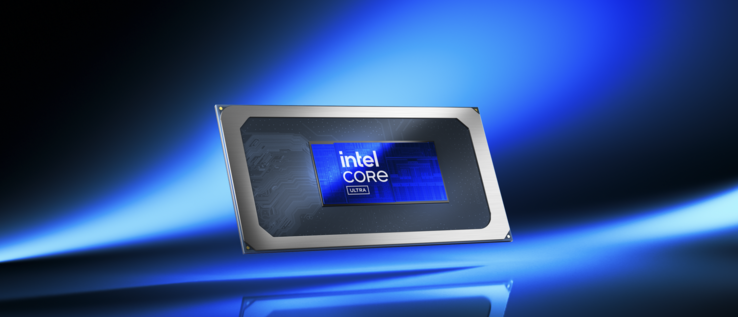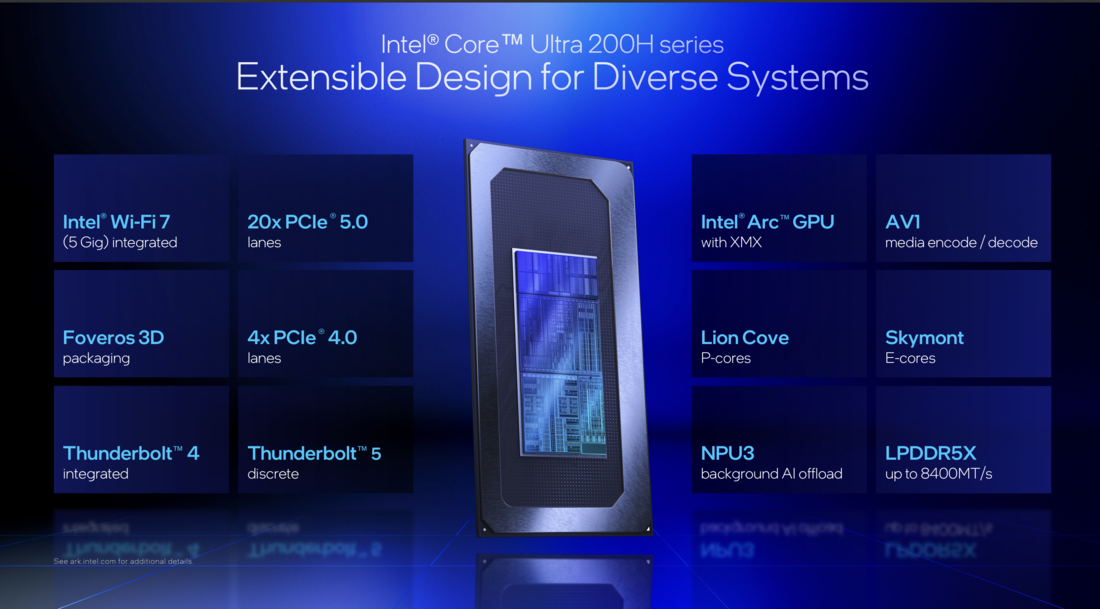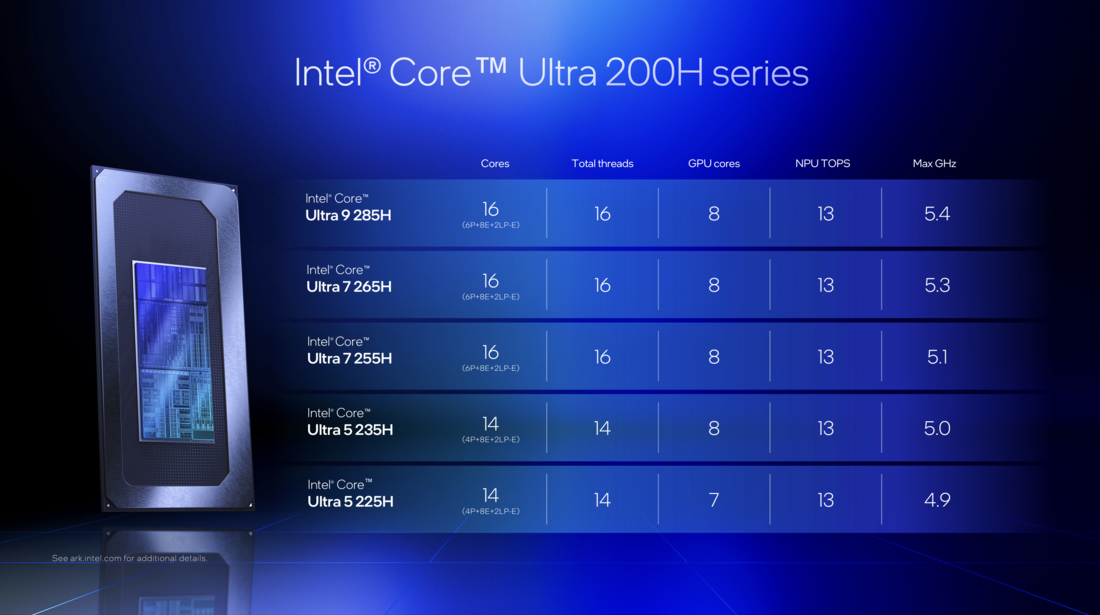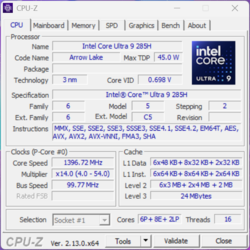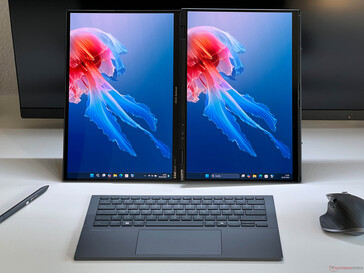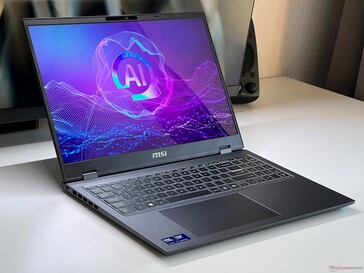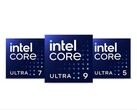Intel Arrow Lake-H CPU analysis: Core Ultra 200H makes Lunar Lake almost redundant
Overview Intel Core Ultra 200H
With Meteor Lake, Intel introduced a new naming scheme last year, moving from Core i7-13700H to Core Ultra 7 155H, while also adopting a tile-based architecture for its mobile processors.
Last September, Intel unveiled Lunar Lake (Core Ultra 200V), a monolithic mobile processor lineup developed by a separate team within Intel. These chips were designed with efficiency in mind, featuring a significantly lower range of 15-37 watts.
Now, Intel is launching Arrow Lake, starting with the H-series (Core Ultra 200H), which is positioned as the true successor to Meteor Lake. These processors cover a wider TDP range of 28-115 watts, making them better suited for higher-performance laptops.
However, with both Lunar Lake and Arrow Lake coexisting, there will inevitably be overlaps between the two lineups, potentially causing confusion for consumers.
The Arrow Lake-H CPUs are manufactured using TSMC’s advanced nodes: N3B for the CPU tile, N5 for the GPU tile, and N6 for the SoC and I/O components. Intel then assembles the chips using its Foveros 3D packaging technology. According to Intel, improved packaging has allowed for a chip size reduction of up to 33%.
As with Lunar Lake, Arrow Lake-H features Lion Cove Performance cores and Skymont Efficient cores. However, a key change from previous Redwood Cove P cores is that Hyper-Threading is no longer supported. This means that while the Core Ultra 7 255H comes with 16 cores, it can only process 16 threads simultaneously, whereas the Meteor Lake Core Ultra 7 155H (also with 16 cores) supported 22 threads. Despite this, multi-core performance is expected to improve significantly.
There are no major changes in other key features. Arrow Lake theoretically supports Thunderbolt 5, but this requires an additional chip. As a result, most Arrow Lake-powered laptops will continue to ship with Thunderbolt 4.
Intel also claims improved AI performance, with the Arrow Lake chips reaching up to 99 TOPS. However, this figure represents the combined performance of the CPU, GPU, and NPU. The NPU itself remains relatively weak, delivering just 13 TOPS—a stark contrast to Lunar Lake's NPU, which reaches up to 48 TOPS.
As a result, Arrow Lake laptops fail to meet the 40-TOPS NPU minimum required for the Copilot+ certification. Despite this, Windows AI-powered features—such as Studio Effects for webcams and live captions—are still supported.
However, the future compatibility of Arrow Lake laptops with upcoming features like Recall remains uncertain. We will cover the integrated graphics updates in more detail in a separate article.
At launch, five models from the new Arrow Lake-H series will be available. These include the high-end Core Ultra 9 285H, which reaches clock speeds of up to 5.4 GHz, along with two Core Ultra 7 and two Core Ultra 5 variants. The models differ in maximum clock speed, number of performance cores, and integrated GPU, as outlined in the table below.
However, buyers should be cautious, as only models with the "Ultra" branding and a "5" at the end belong to the new Arrow Lake generation. CPUs with a "0" at the end (e.g. Core 5 220H, Core 7 250H) are Raptor Lake Refresh chips, which are based on a much older architecture.
Test systems - Asus and MSI deliver the first models
The two test systems used for benchmarking are the Asus Zenbook Duo and the MSI Prestige 16 AI Evo, both powered by the Core Ultra 9 285H. These devices feature different power configurations, which directly impact overall performance.
In the Zenbook Duo, the processor reaches a peak of 60 watts but stabilizes at just 24 watts under sustained load. In contrast, the Prestige 16 AI Evo sees an initial spike to 115 watts, before quickly settling at 45 watts. Due to these variations, short-duration benchmarks offer a better indication of potential multi-core performance.
We will also be adding benchmark results for the Core Ultra 5 235H soon.
Testing conditions
To ensure a meaningful comparison between different processors, we evaluate power consumption alongside synthetic benchmark performance, allowing us to determine overall efficiency.
Our power consumption measurements are conducted using an external display, eliminating any influence from varying internal display power usage. However, it is important to note that we measure total system power consumption, rather than just comparing raw TDP values.
Single-core performance & efficiency
We have already observed strong single-core performance from Lunar Lake processors, but it’s no surprise that the Core Ultra 9 285H—featuring the same P-cores but a higher clock speed of 5.4 GHz (+300 MHz)—performs slightly better.
In the Cinebench 2024 multi-core test, the Core Ultra 9 285H holds a 4% lead over the Core Ultra 9 288V and delivers a significant 18% improvement over its direct predecessor, the Core Ultra 9 185H. This allows Intel to catch up with Qualcomm’s fastest Snapdragon X Elite chip (X1E-84-100).
The advantage over AMD’s latest Zen 5 models is around 10%, while Apple’s M3 generation pulls ahead by 11%. However, the M4 chips remain in a league of their own, boasting an almost 40% performance lead.
In Geekbench, the Arrow Lake chip also delivers strong results, though the gap between competitors is noticeably smaller.
The Arrow Lake CPUs show a slight efficiency improvement over the older Meteor Lake chips, but Lunar Lake still holds a small advantage. This is primarily due to differences in chip design, as well as Arrow Lake’s slightly lower maximum clock speed.
At higher clock rates, power consumption remains relatively high, with total system draw reaching 33-34 watts on an external monitor. AMD’s Zen 5 chips are comparable in efficiency, but ARM-based competitors—particularly from Qualcomm and Apple—maintain a clear lead in single-core efficiency.
* ... smaller is better
Multi-core performance & efficiency
With only 8 cores, Lunar Lake processors offer limited multi-core performance. In contrast, the new Arrow Lake chips feature 16 cores and higher power limits, naturally giving them an advantage in multi-threaded workloads. However, power limits play a crucial role in performance, as Intel’s new CPUs perform well in short-load scenarios and synthetic benchmarks. In multi-core Geekbench 6 and Cinebench R23 tests, they generally match the performance of AMD’s Zen 5 chips.
However, when running longer, sustained workloads, such as the multi-core Cinebench 2024 test, the short-term power advantage fades. In practical scenarios, much of the benchmark runs at 35W/24W on the Asus Zenbook Duo and 45W on the MSI Prestige 16. Under these conditions, the Core Ultra 9 285H only matches the Ryzen AI 9 365, which Intel considers its primary competitor.
That said, we believe the Ryzen AI 9 HX 370 is the true competitor, as it outperforms Intel’s offering. Additionally, Snapdragon X Elite CPUs deliver comparable or better performance, while Apple’s standard M4 chip matches Intel’s Core Ultra 9 285H, despite drawing significantly less power. Meanwhile, the M4 Pro chips are substantially faster.
The Core Ultra 9 285H models deliver strong multi-core efficiency, even outperforming Lunar Lake chips. This advantage is largely due to lower power limits and the efficiency curve of modern processors, where chips become less efficient at higher clock speeds.
To illustrate this, imagine both a Lunar Lake and an Arrow Lake processor running at 30 watts. The Lunar Lake chip, with its 8 cores, operates at higher clock speeds, whereas the Arrow Lake chip, with 16 cores, runs at lower clock speeds but remains in a more efficient operating range. As we will see later, the new cores do not scale as well with higher power limits compared to Meteor Lake, meaning extra power no longer yields the same level of performance gains.
While AMD’s high-performance Zen 5 chips fall behind in multi-core efficiency, Apple and Qualcomm’s ARM-based processors maintain a slight advantage. However, unlike in single-core performance, the efficiency gap here is much smaller.
* ... smaller is better
Performance with different power limits
Since final performance varies significantly depending on the laptop model and power limits, we also ran the Cinebench 2024 multi-core benchmark with controlled power settings. For this, we used ThrottleStop and Universal x86 Tuning Utility, though these tools are limited to Intel and AMD processors, respectively.
In the MSI Prestige 16, the processor can sustain a maximum of 55 watts. We will provide results for higher power limits as soon as additional data becomes available.
| TDP | Core Ultra 9 285H | Ryzen AI 9 HX 370 | Ryzen AI 9 365 | Core Ultra 7 258V | Core Ultra 7 155H |
|---|---|---|---|---|---|
| 15 Watt | 451 points | 621 points | 590 points | 445 points | 271 points |
| 20 Watt | 597 points | 760 points | 683 points | 512 points | 438 points |
| 28 Watt | 778 points | 927 points | 787 points | 587 points | 637 points |
| 35 Watts | 892 points | 1,022 points | 752 points | ||
| 45 Watt | 977 points | 1,107 points | 887 points | ||
| 55 watts | 1,042 points | 1,167 points | 966 points |
Once again, testing confirms that the Core Ultra 9 285H cannot compete with the Ryzen 9 AI HX 370, instead performing on par with the Ryzen AI 9 365. Interestingly, the performance gap between the Core Ultra 9 285H and the Core Ultra 7 155H (which has the same number of cores) is relatively small, with improvements ranging from 8-22% across TDPs of 28-55 watts.
One key takeaway is that Arrow Lake performs exceptionally well at lower power limits but sees diminishing returns at higher TDPs. At 55 watts, the performance difference is only in the single-digit percentage range, suggesting that Arrow Lake does not benefit significantly from extreme power scaling.
Further testing with more devices will be needed, but it is possible that Arrow Lake chips may offer little to no performance advantage beyond 80 watts—a power level many high-performance multimedia laptops can sustain continuously. On the other hand, Arrow Lake already outperforms its Lunar Lake counterpart at just 20 watts, highlighting its efficiency at lower power levels.
Verdict - Arrow Lake shows the current problems at Intel
The new Arrow Lake mobile processors leave a mixed impression in our analysis. As the successor to the Meteor Lake generation, they now use the same cores as Lunar Lake, leading to better performance and improved efficiency, particularly at lower power limits between 20 and 45 watts. The Core Ultra 9 285H delivers solid single-core performance, making it most comparable to the AMD Ryzen AI 9 365, though the Ryzen AI 9 HX 370 remains out of reach. Intel has closed the gap with the competition, but it hasn't taken the lead. Qualcomm’s Snapdragon X Elite chips provide even better multi-core performance at high power levels and greater efficiency overall, while Apple’s M4 generation continues to operate on a different performance level.
As with Meteor Lake, Arrow Lake-H processors cover a wide TDP range from 28 to 115 watts, which creates several challenges for end users. A processor's model number alone does not provide an accurate picture of real-world performance, as power limits and cooling solutions vary between laptops. This means a Core Ultra 7 255H in one laptop may perform better than a Core Ultra 9 285H in another, depending on the system’s cooling and power allocation. High short-term power spikes (such as in the MSI Prestige 16 AI Evo) can also strain power adapters, forcing some laptops to briefly draw power from the battery. Increased power consumption also leads to more demanding cooling requirements, which can cause fans to ramp up quickly.
Intel is downplaying the weak NPU performance and lack of Copilot+ certification, instead focusing on the AI capabilities of the overall platform, particularly the GPU. While features like studio effects for webcams and live subtitles do work, it remains unclear how/if future AI-dependent functions like Recall will be supported.
The overlap between Lunar Lake and Arrow Lake illustrates Intel’s current development challenges. With low-power Arrow Lake chips already outperforming Lunar Lake, the latter is starting to seem redundant. Instead of pushing Lunar Lake past 30 watts, it might make more sense to focus on passively cooled designs. However, this issue may be addressed with the upcoming Panther Lake generation if current reports are accurate.
Despite these issues, Arrow Lake-H processors will likely find success, as Intel remains strong in terms of availability, unlike AMD. Over the next few weeks, many new Arrow Lake-powered laptops are expected to be released. Once we have performance data for the Core Ultra 7 and Core Ultra 5 models, we will update this article accordingly.




